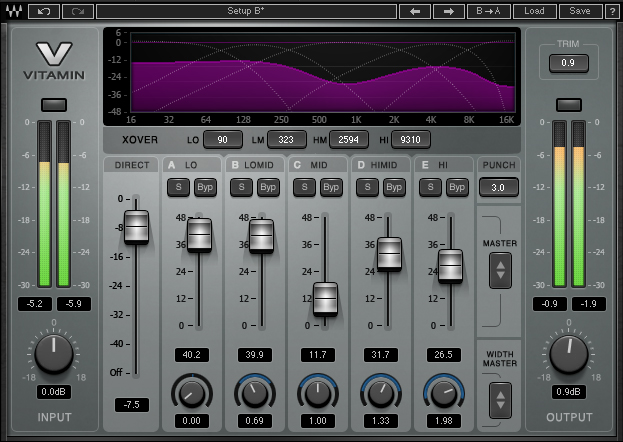Welcome back to week 2 of our Waves series talking about my top 5 plugins. As I mentioned last night, I see this question being asked all the time, sometimes of me, and so I thought I’d do a series talking about my top 5 plugins, how to operate them, and how I use them. Last week (here is a link in case you missed it) I talked about the CLA-76. While I use it a lot, I can often get pretty close with other options in the arsenal if I can’t use it. This week, I’m talking about harmonizers. It was really a toss up between two plugins with an ever-so-slight winner. This tie is made of Vitamin Sonic Enhancer and Scheps Parallel Particles. Both sound great, are easy to use, and are used frequently if I get the chance. Vitamin allows for granular control over what is added while Parallel Particles allows for a more cohesive experience because of it’s design. I give the edge here to Vitamin however. Because you can really tweak exactly what you want to add that, in my mind, gives it the edge because in theory you can create what you hear in Scheps with Vitamin. But, I use Scheps a lot where I used to use vitamin because I can get what I want quicker and easier while vitamin takes a bit to get really dialed. In many ways, Scheps is the one-knob plugin for harmonizers. However, for things like toms where I need to really control and tune what is happening Vitamin is the perfect fit and if I had to pick just one, I’d land with the Vitamin Sonic Enhancer.
Waves describes Vitamin like this, “Waves Vitamin is a multiband harmonic enhancer and tone-shaping plugin that can make any track sound powerful and full of spark by mixing an enriched version with the original signal.” Sort of like the C6 in operation, you set the frequency band in which each channel of the plugin works, set stereo width, and then attenuate the direct sound (what equates to a wet/dry knob) and that’s it. It also has a convenient punch setting that works a lot like the punch knob in Hcomp which can create some fun adjustments. Often times I’ll get the plugin reacting like I want it to with the 5 channels and then grab the master and adjust to taste. If you struggle to get moving or don’t know where to start the plugin is loaded with presets that can get you pretty far down the road.
Probably a favorite and yet underused feature of this plugin is the solo option. When you click on it, you hear what is happening in the band only. This can really help you identify what needs to go up or down as you can solo one or a few of them to help identify where things are going wrong if you are having issues. Another great feature is the direct fader. Think of it like this, there are two paths for the audio through the plugin one is unprocessed, one is processed. You can’t attenuate the wet path but you can mix in or out, the direct path which can help you really get the exact amount of harmonics added. This feature differentiates this plugin from most other harmonics plugins because, much like old school FX units, you are basically getting what equates to a wet/dry setup.
I could find myself using it on toms when I need a really big tom sound for big concerts or just a bigger/wider sound. I also use it regularly on electric guitar inputs to accentuate their role in the song (for lead guitars I use it to enhance the presence and top end, for rhythm guitars vitamin helps me get a big deep phat sound). My acoustic guitar chain usually has a parallel particles inserted in the middle of the omni-channel but I occasionally need to swap out for vitamin if I’m having a tough time locking it in. I love to use it on synths and electric pianos as well to help things just pop.
So that’s number 4, the Vitamin Sonic Enhancer. Do you guys use it alot? If so, what do you use it with? Any tricks I didn’t mention? Let me know in the comments below! Next we are on to dig into my top 3 plugins starting with a plugin that probably everyone knows about. If you don’t want to miss out be sure to subscribe at this link. Lastly, if you have any questions, email us at engineers@studiostagelive.com and we’ll get back to you as soon as we can. See you all on the flipside!


I think the width knob is one of the coolest features of the plug in. It can totally change the character of a sound by adding frequency-dependent wider or narrower stereo imaging.
Yep, I dont end up using this a lot live because of my philosophy of mixing stereo in a live room but it is quite fun to tweak in a studio